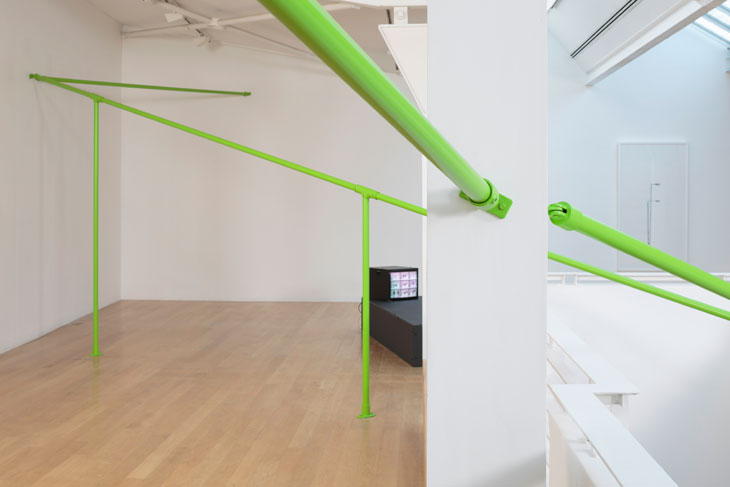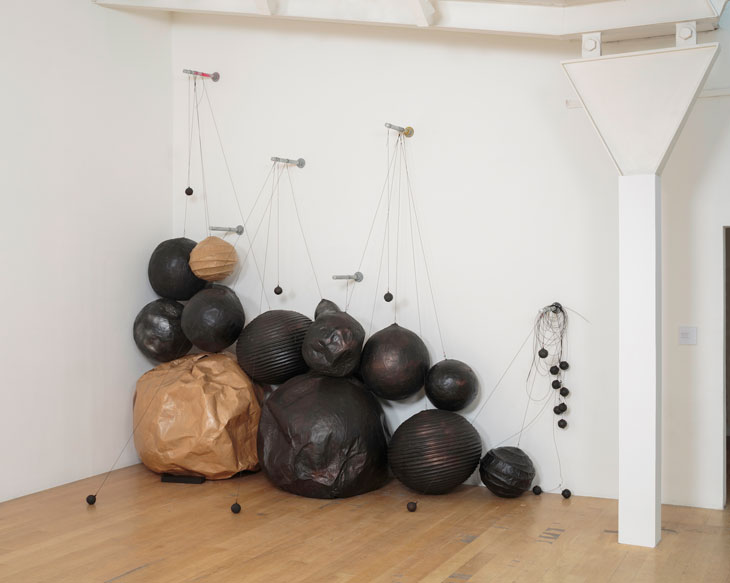A series of street lamps, sketched in pencil, stand sentinel like herons. These black-and-white drawings, some of the newest work in Jacqueline Donachie’s mid-career survey ‘Right Here Among Them’ at the Fruitmarket Gallery, are not as innocuous as they first appear: one has a helmet of spikes to ward off pigeons; another is wreathed in security cameras.
In the exhibition space, this often-overlooked infrastructure of the urban environment is invoked by green and black powder-coated aluminium poles, which divide the upper gallery. One zig-zags through the air at a slightly crazy angle, not quite close enough to hit your head on, but almost. These poles – or pipes, or handles, or guiderails – seem like they could be helpful, but their purpose is unclear. One thing they do is gently nudge you to reconsider your relationship to walls and floors, making your eyes work just that bit harder to decode the surrounding terrain.
Walk With Me (2017), Jacqueline Donachie. Courtesy of the artist and Patricia Fleming Projects, Glasgow. Photo: Ruth Clark

The impetus behind these recent drawings and sculptures can be found in a video work from 2016, titled Pose Work for Sisters. In the recording, Donachie and her sister Susan re-enact Bruce McLean’s Pose Work for Plinths, a performance action from 1971 in which McLean was photographed arranging himself on two white plinths. On a small television monitor screen, divided into a grid of three frames by three, we watch the sisters perform a series of balancing acts. They are of a similar build, and in the fuzzy vignettes it is difficult to tell them apart. But gradually differences in the movements of their bodies become apparent; at one point the artist has to position her sister’s legs for her. The artwork developed as a response to Susan’s discovery that she had inherited a rare muscular degenerative disorder called myotonic dystrophy, the effects of which become apparent earlier in life with each generational jump. Pose Work for Sisters challenges normative constructs such as ‘able-bodied’, but it also demands that viewers be alert for differences, and consider their lived effects.
As I moved my own body around the show, I thought about how it does not take very much for the urban environment to become a nightmarishly challenging terrain. Broken lifts at train stations, cobblestones, potholes in pavements, and shops where the clothesrails are packed too tightly to push a wheelchair through – if you fit standard definitions of ‘able-bodied’, you might rarely notice the unthinking cruelty of this infrastructural intransigence.
Between One Thing and Another (2017), Jacqueline Donachie. Photo: Ruth Clark; courtesy of the artist and Patricia Fleming Projects, Glasgow.

Something of this disguised menace inflects works like An Era of Small Pleasures (2017), which in its form emulates a festive paper chain but is actually made from heavy loops of dark leather, or Between One Thing and Another (2017), a sculpture made up of a series of spheres. Some of the balls appear as light as a paper lantern, but others seem much heavier, bound to the wall with taut strands of steel. For once it is a relief not to be able to interact with a sculpture; you suspect that if you tried to pick up a piece, it would either prove too heavy or unexpectedly light, and either way you would be wrong-footed.
The exhibition is organised chronologically, with Donachie’s earliest work cosily stowed in the dimly lit lower galleries. The space is dominated by Advice Bar (Expanded for the Times) (2017), a reworking of a piece Donachie developed in the 1990s while studying for an MFA in New York and working in a bar. In its initial incarnation Donachie staffed the small, makeshift drinks and advice counter herself; at the Fruitmarket, it has become a large minimalist slab, to be ‘activated’ by other groups and organisations dispensing counsel. In another room on the same level, we encounter an even earlier work, from 1994: Part Edit, Track A (Repurposed for Waverley). The plasterboard on an external wall has been removed, revealing grey bricks that radiate cold, onto which Donachie has placed two speakers relaying a sound work first presented at Glasgow’s Tramway. The tracks are now faded and ghostly, lost in the din rising up from the nearby Waverley station.
Advice Bar (Expanded for the Times) (2017), Jacqueline Donachie. Photo: Ruth Clark; courtesy of the artist and Patricia Fleming Projects, Glasgow.

The difference between the works on the two levels is discernible, and reflects the exhibition’s genesis in the Freelands Award, an initiative launched in 2016 that enables a regional gallery to collaborate with a woman artist, and realise a mid-career show focusing on new work. The result is not quite a retrospective, but rather two views of an ongoing practice re-oriented by the discovery of new questions and concerns.
‘Jacqueline Donachie: Right Here Among Them’ is at The Fruitmarket Gallery, Edinburgh, until 11 February.



